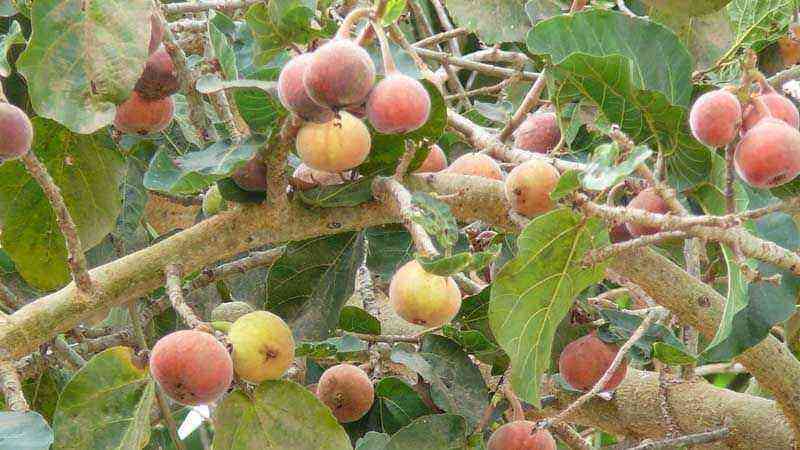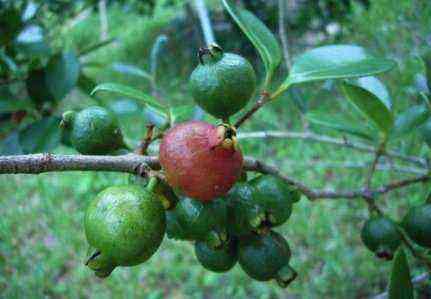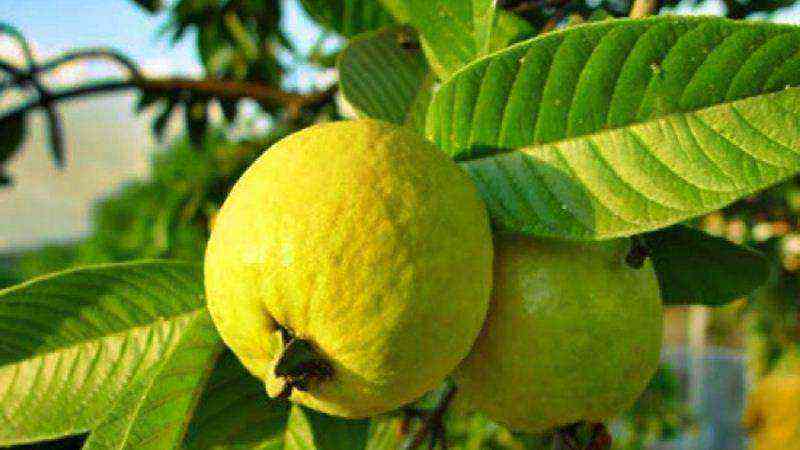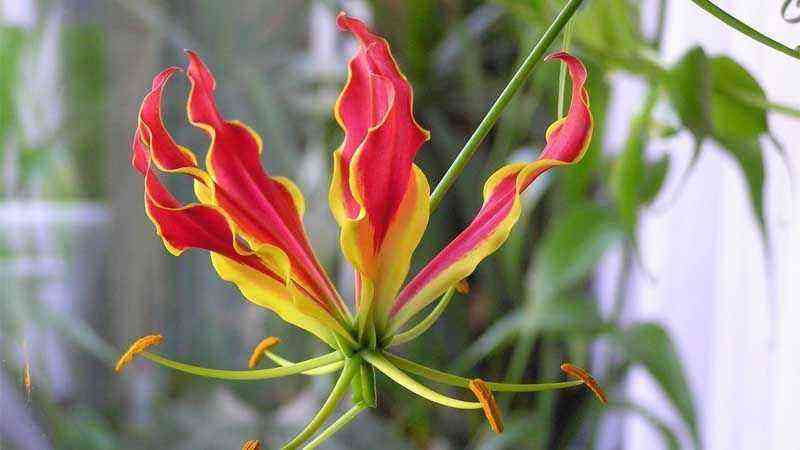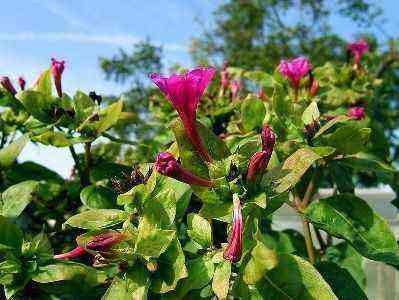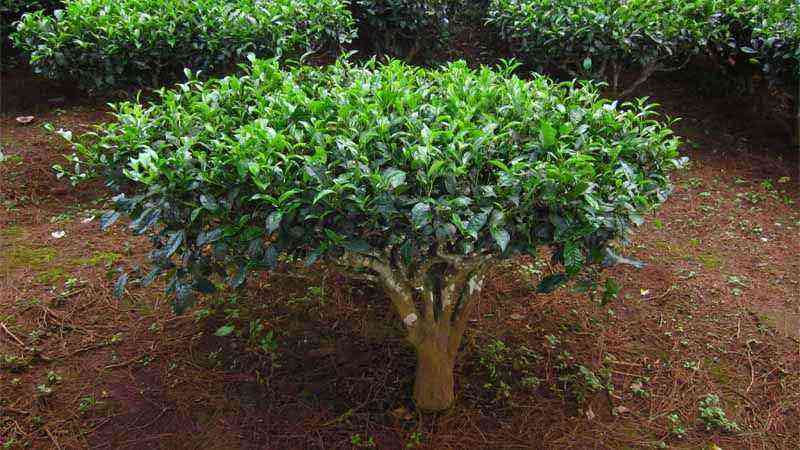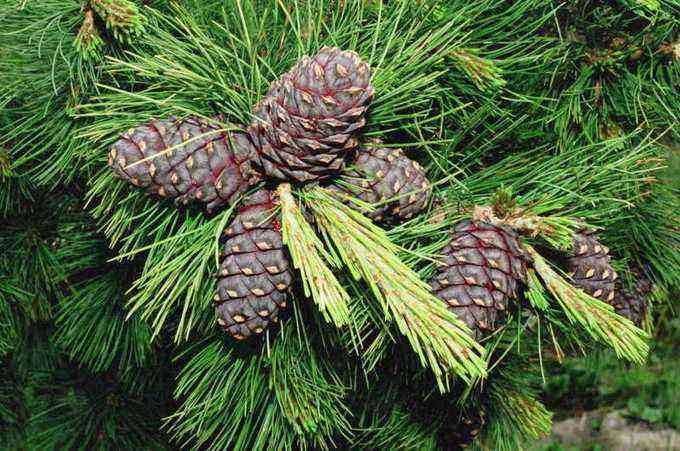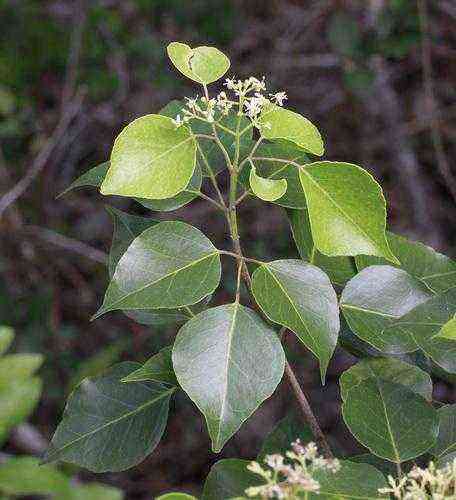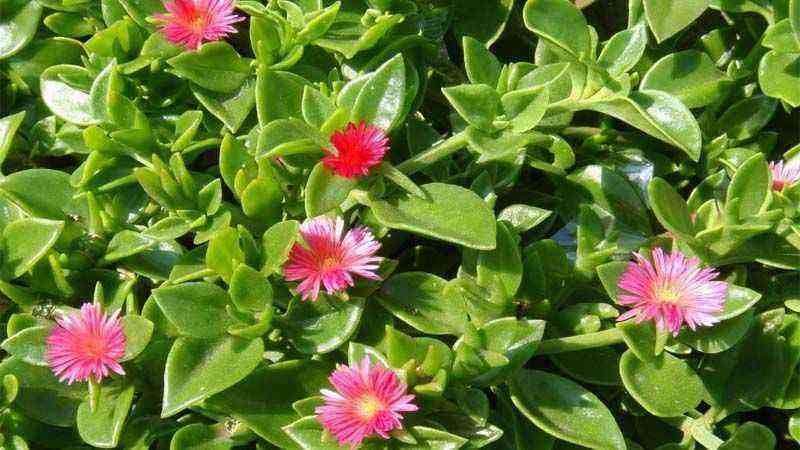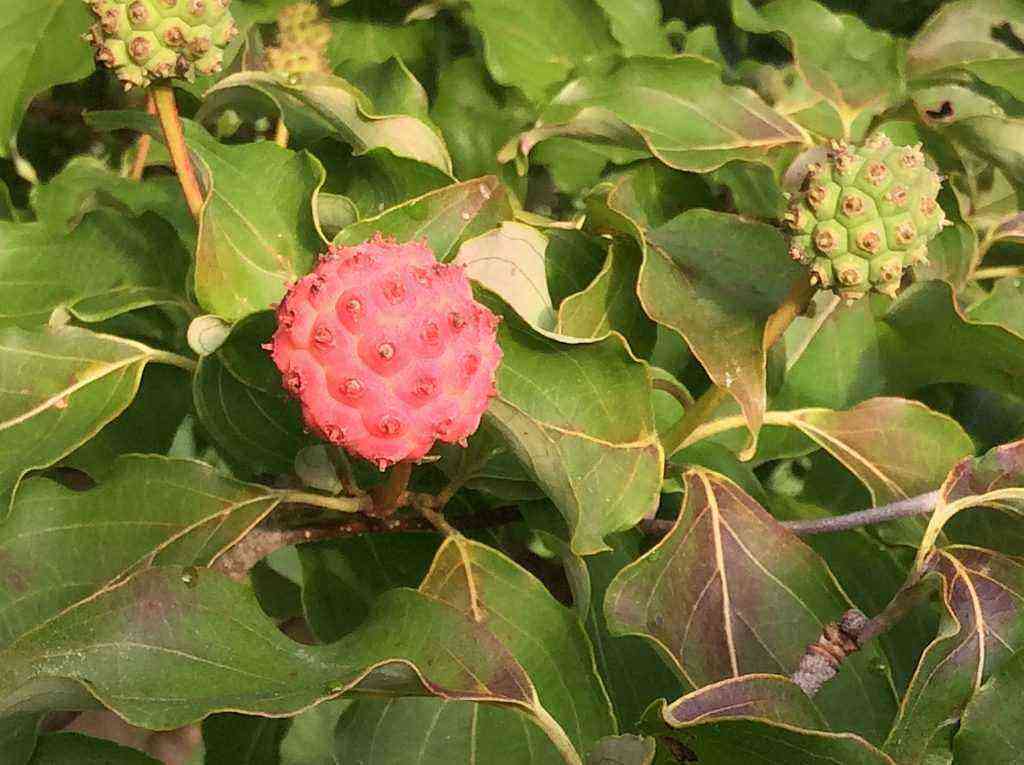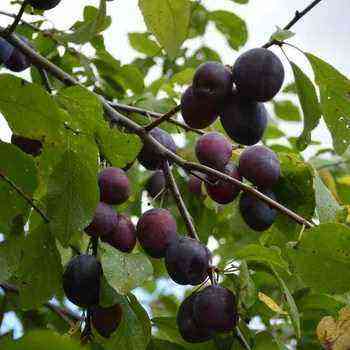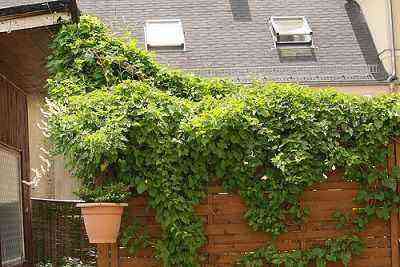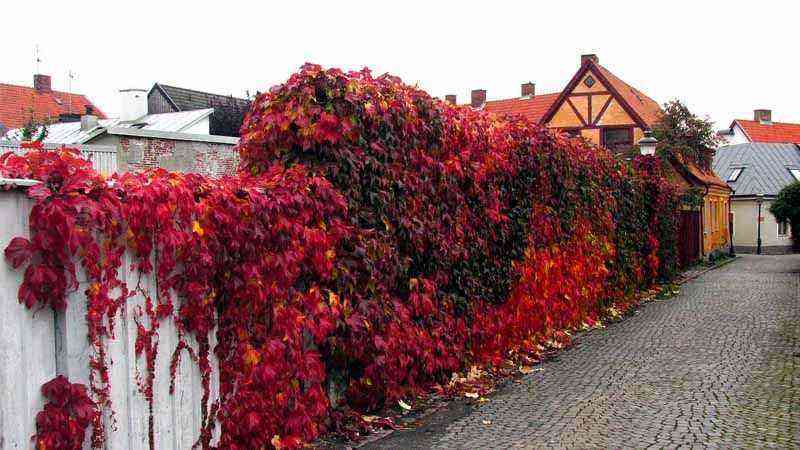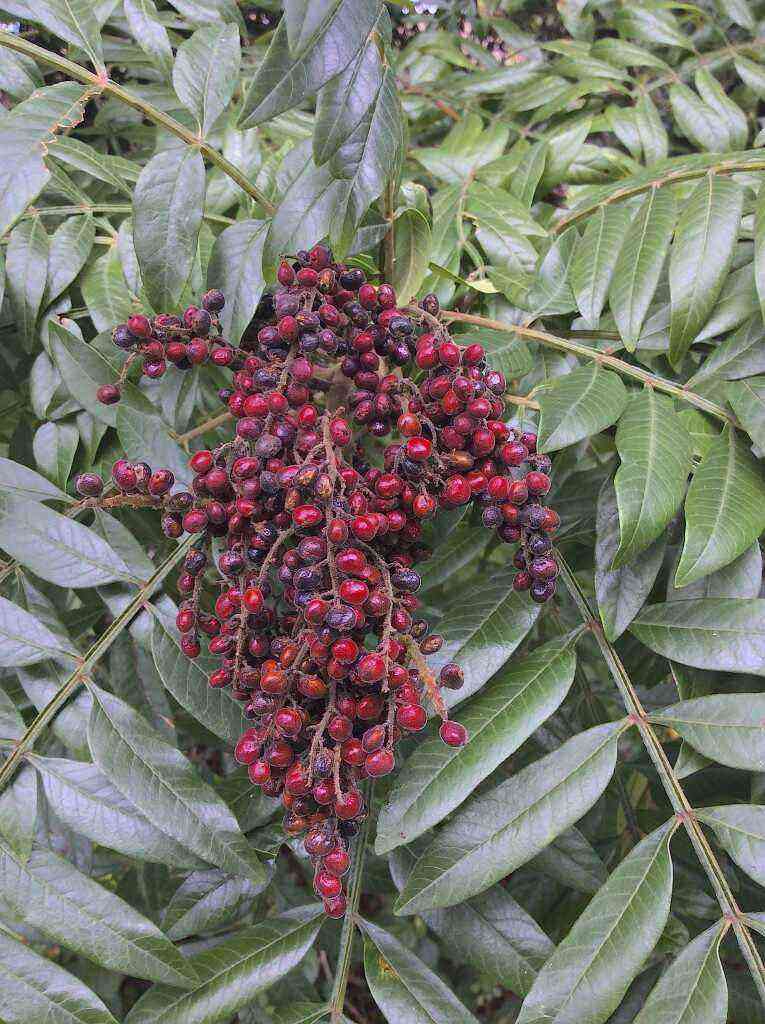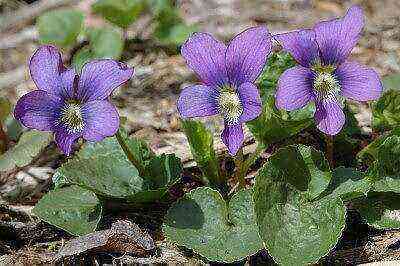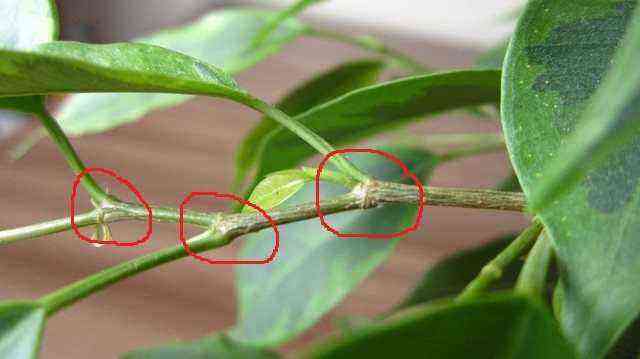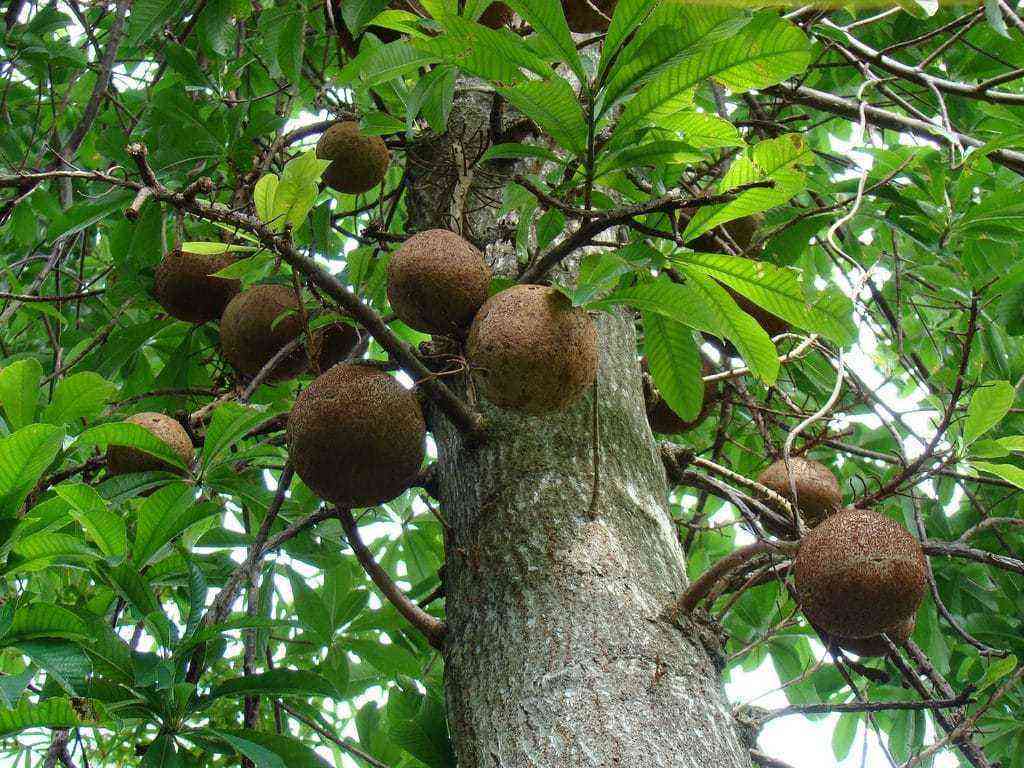For amateur gardeners and landscape designers today, there is a large variety of cultures that help to realize the most daring ideas for the design of private households and parks. In this list, dwarf lilac deserves special attention, which is represented by a large variety of species and varieties.
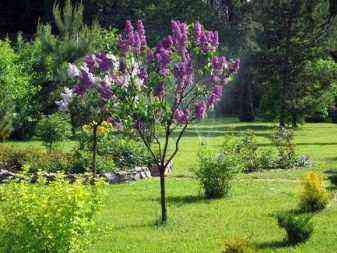
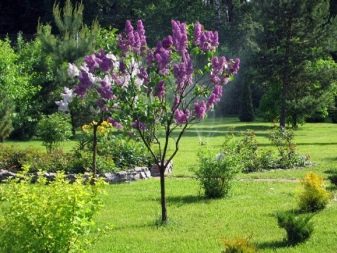
Features
This culture is a perennial, which is a low tree-shrub. As a rule, lilac grows everywhere, but prefers sunny and mountainous terrain. Dwarf lilacs should be attributed to the olive family. Today, in nature, you can find both wild shrubs, the formation of which occurred in the light of natural pollination, and varieties grown by man artificially.
The classification of crops is based on differences in flowering time, color and shape of inflorescences, as well as the height of the bush.
Today, dwarf crops are especially in demand in landscape design due to their attractive appearance and fragrance. Therefore, culture can be found in private localities and in public parks. Ornamental lilac bushes are characterized by their unpretentious care, resistance to negative external factors, as well as low generative indicators.
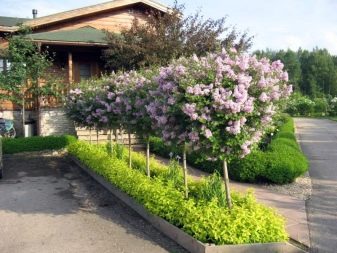
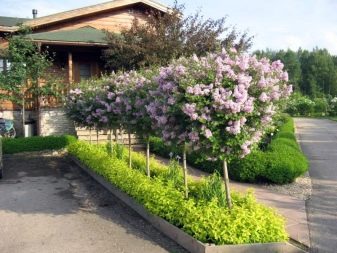
This plant stands out among many ornamental crops for its individual characteristics.
- Dwarf lilac bushes tolerate temperature drops very well. Today, there are varieties that retain their viability even at -40 ° C without the use of covering materials. This characteristic makes it possible to grow crops in regions with harsh winters.
- Plants do not require special care after planting. As a rule, agricultural technology is not much different from standard measures for the cultivation of horticultural crops.
- In addition to frost resistance, dwarf lilacs are drought tolerant. Some species will be able to withstand a week of heat without additional moisture.
- In decorative varieties, the vegetative process proceeds rather slowly, the crops slightly increase in size, so that they do not need frequent pruning or crown formation.
- Lilacs on the site will act as a natural air purifier, since the plant can absorb exhaust gases and various radiation.
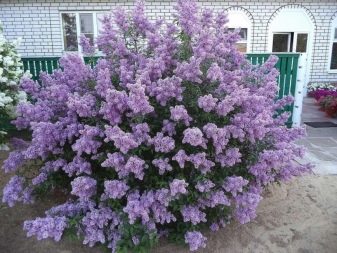
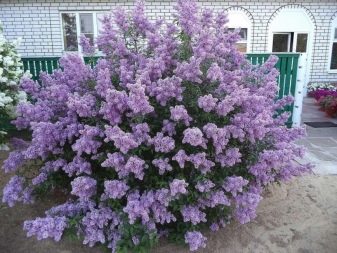
Among the weaknesses of the shrub, it is worth noting the low survival rate of young crops, as well as a rather long adaptation after rooting.
LILAC EXPLOSION OF Dwarf Persian Lilac …
LILAC EXPLOSION OF Dwarf Persian Lilac …
Bright lilac bloom … Gardeners often plant lilacs on their plot so that it pleases with its unusual and vibrant flowering. Large and beautiful racemose inflorescences usually have an unusual specific odor. But, besides this, the lilac bush itself gives any garden plot a well-groomed and blooming look. It is worth noting the fact that the greenery on the lilac bushes lasts until the very frost. The flowering period depends on which variety will be chosen by the gardener for his site. So, ordinary lilac blooms from mid-May to late June. Today it can be argued that there are already more than 30 varieties and species of this plant, which belongs to the Olive family.
Description of lilac Varietal lilacs can always be the highlight of any garden plot, delighting the owners with their flowers. There are different versions of where the lilac got its name from. One of them claims to be from the name of a musical instrument that was in ancient Greece. Such a flute was made by the forest god Pan from the reed, into which the nymph Siringu was once turned. If we consider the poetry of symbolism, then we can trace that white lilacs are associated with first love. It is known that in some states of America there are even festivals dedicated to lilacs. Lilac is a lovely small shrub that blooms in May-June. The height of such a shrub ranges from 2 to 10 meters, and the trunk diameter depends on the age of the tree and can reach up to 30 centimeters. Lilac leaves are opposite, which fall for the winter. Usually the leaves are pinnately – separate, but there are also whole ones.
The inflorescence of the lilac is also interesting: a panicle with small bisexual flowers. Common lilac is the most common and can be varied in color, from white to dark purple. If you look closely, you can see two stamens in the flower. And these complex inflorescences themselves have a persistent and pleasant aroma. The fruit is a small box, dense, brown, bivalve. It contains two oblong seeds in each valve. The lilac bush can last up to 90 years.
Types and varieties of white lilac Unfortunately, it has not yet been established exactly how many types of lilacs there are in the modern world. Some botanists name 13 species, and others – more than 30. But this is about natural species, and there are also hybrid varieties that have occurred as a result of crossing different species. But the number of permanent hybrid varieties cannot be precisely named, since they are constantly increasing. For example, hybrid varieties include: But the type of Persian lilac deserves special attention. It can be attributed to hybrid varieties, since it appeared due to the crossing of two natural species: Afghan and small-cut. The appearance of this variety dates back to 1640. The Persian lilac bush grows up to 2 meters high, its branches are spread out and thin.
Multi-flowered inflorescences reach a length of 10 centimeters, and their width will be equal to 7-8 centimeters. The color of the flowers is white or with a lilac tint, but very fragrant. Persian lilac bushes begin to bloom in May and can end their flowering only at the end of June. This lilac look easily tolerates high frosts and droughts. Unfortunately, it is almost impossible to meet it in the wild, but it does not require special care either.
Hungarian lilac for hedges An interesting hybrid type of terry lilac, which has been widely used since 1855. Its height is usually 4 meters, but it has dense foliage. Got spread in some provinces of China. It differs in that the shoots rush upward, and the young branches have a yellow-gray color. Inflorescences are 30 centimeters long, erect and paniculate. The shape of the inflorescence is usually either pyramidal or cylindrical. The flowers are purple or tinged with pink, but very fragrant. The corolla has a narrow tube that expands upward. This terry lilac blooms in June-July, and therefore belongs to the late varieties. Resistant to cold weather. But the most common natural species are the following lilac bushes: Ordinary. Broadleaf. Hungarian. Zvyagintsev. Komarov. Wolf. Amurskaya. Mesh. Small-leaved. Fluffy. Feathery.
Common lilac is a small tree, the height of which ranges from 2 to 7 meters. This shrub has a well-branched root system. Its bark is gray and the branches are yellowish. The root system saves slopes from erosion. Oval leaves have pointed ends, they are oval and smooth. At the base, the leaves are cordate, 10 centimeters long and 5 centimeters wide. Deciduous petioles are 15 centimeters long. Flowers of this type of lilac bush appear in May along with the leaves. Usually flower inflorescences are dense and multi-flowered. The flowers themselves are small and fragrant. Most often, such lilacs can be found in forests and on slopes. This type of lilac bushes has been proven to withstand the most severe frosts, tolerate dry weather, and can even grow in areas with a lot of shade.
Lilac Komarova The broad-leaved variety of the lilac bush is similar to common lilac, but there are some differences: small flowers, large leaves and flowering begins earlier. The shrub of Hungarian lilac grows up to 4 meters high, and the trunk is gray in color. The shape of the leaves is interesting: oval, with a width of up to 3 centimeters, and up to 8 centimeters long. The roots of the leaves are small: up to 2 centimeters. The branches of this species are erect, if the bush is young, then they are slightly lowered. Flowers are collected in multi-flowered panicles, fragrant, dark. This lilac bush blooms in June. You can find them in the forests of Ukraine, Hungary, Romania and Yugoslavia. Other species are similar to the Hungarian lilac bush, for example, the lilacs of Zvegintsov, Komarov, Wolf.
Lilac Amur lilac surprises with its size. It looks more like a tree than a shrub, because only its height reaches 10 meters. You can meet such lilacs in the Far East, therefore, flowering begins late, at the end of June. The lilac bush of the net type has fluffy creamy flowers. She is Wolf white lilac – a beautiful variety of lilacs widespread in the ornamental floriculture of the West due to small leaves, as well as a type of small-leaved lilac bush and fluffy lilacs. The plumose species is distinguished by pinnately-separated leaves. It is worth noting that an international classification of lilac exists, and in it the varieties are described based on what shape and color the flower has.
Growing and caring for lilacs In order to plant lilacs on your garden plot, you need to choose those places where there is good lighting. Many varieties of lilac bushes do not like high moisture soil, as this can be detrimental to their root system. But the soil is rich in humus, slightly moistened, and with an acidity of 5 to 7 will be just ideal for them. But for the winter, you do not need to cover and insulate them. But if the weather is hot and sultry, then watering the lilac bushes is simply a must. Loves lilacs and fertilizers, especially ash and mullein.
Reproduction of lilac Today, there are many ways to breed lilac bushes. For example, growing from seeds. Of course, such a process requires a lot of time and attention. Usually, when grown in this way, it will bloom only for 5 years. Another way of reproduction is to sow the shoots, but this is possible only if there is a good root system. But the very method of reproduction is cuttings.
Pruning lilacs You cannot cut off the shoots of the last year, since it blooms on them. But after flowering, it is necessary to remove all faded inflorescences. The crown of a lilac bush is formed within 2-3 years, so it is necessary to leave only 3-4 trunks, and cut off the rest. The main growth is removed at the base of the bush.
The best varieties and their characteristics
Among the variety of presented species of dwarf lilac, which is sold in nurseries, it is worth highlighting the most popular varieties.
“Meyer”
This variety of undersized lilac includes about four dozen hybrid crops, the frost-resistant variety is especially in demand in central Russia and in the Moscow region. According to the description, flowering in a culture can last about two months. As a rule, the variety enters the flowering phase in early May. The decorative culture reaches a height of one and a half meters, the life cycle varies within 100 years.
Meyera stands out for its incredible aroma, thanks to which low and beautiful shrubs are very often planted in city parks. The color of the flowers, depending on belonging to a particular variety, can be white, cream, red and purple.
Among the most popular varieties of this type are “Pink”, “Palibin”, “White” and others.

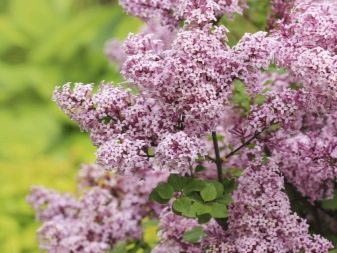
“Superba”
Small-leaved varietal lilac grows no more than a meter. This shrub is very resistant to negative temperatures, compact plants bloom for about 20 days, the first buds appear in early June.
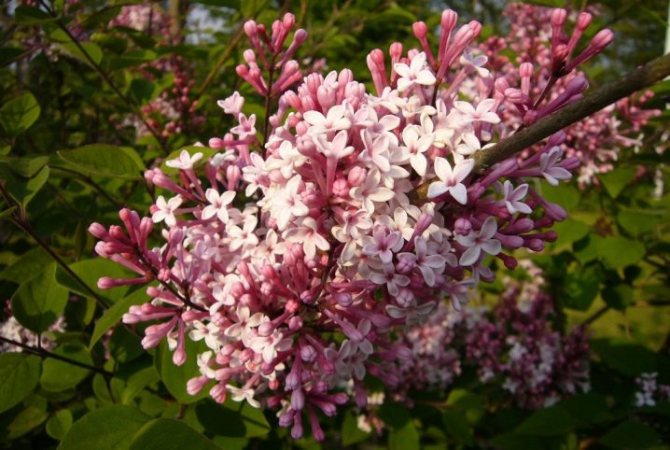
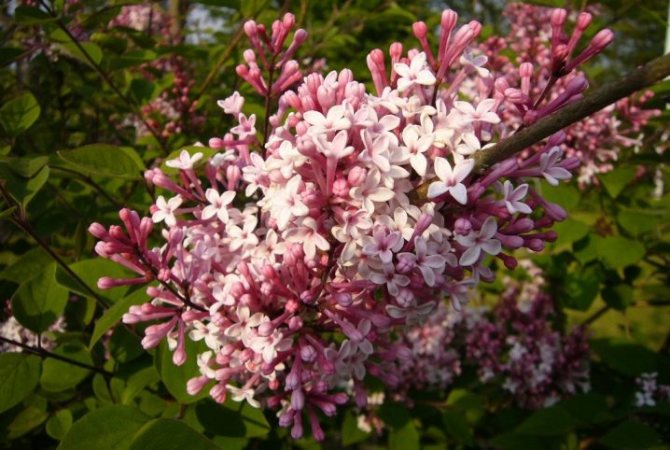
“Schoolgirl”
A type of common lilac, which stands out for its small size. The shrub is very low, as a rule, the height of the plant is no more than 1-1,5 meters. This variety is notable for its purple flowers and resistance to temperature fluctuations.


“Captain Bolte”
Lilac has an average flowering time, the height of the tree is in the region of one meter. The culture blooms with magenta flowers, stands out for the abundance of inflorescences on the crown and resistance to frost.
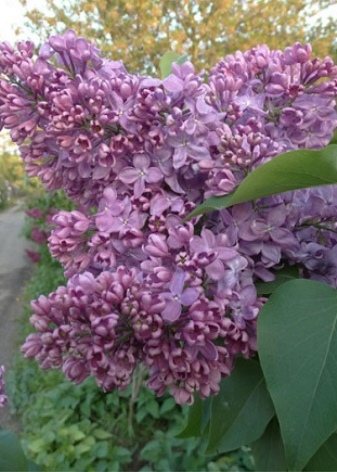
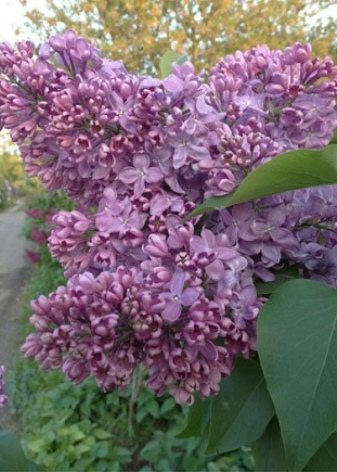
“Madame Charles Suchet”
A variety of dwarf lilacs with high decorative qualities. The culture belongs to the blue type, an adult bush reaches a height of one and a half meters.
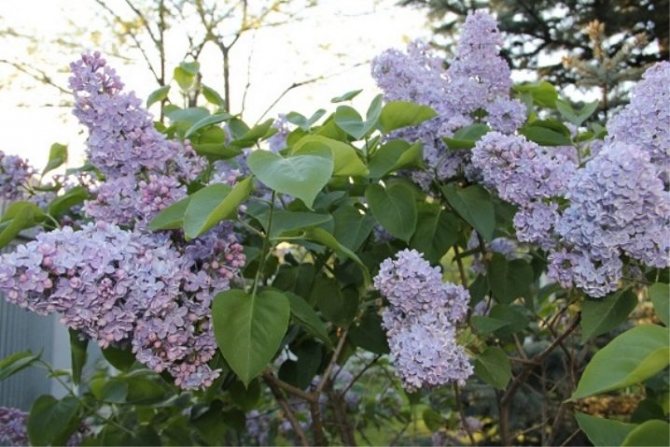
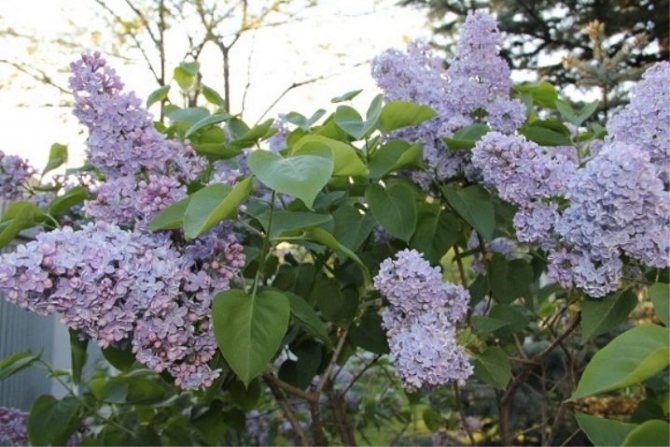
“Jose”
The hybrid variety, which has a very beautiful and spreading crown, develops rather slowly. As a rule, such trees are not higher than one meter. The culture blooms with purple-pink inflorescences with a pleasant sweetish aroma. The hybrid is distinguished by double flowering, the first phase begins in the last days of May, the second – in the second half of August.
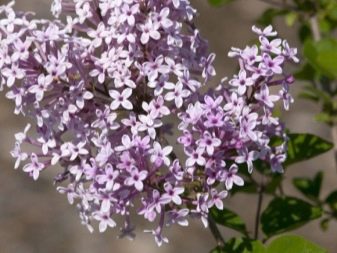
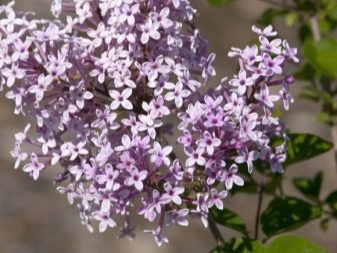
Red Pixie
A popular hybrid with a height of 1 meter, which belongs to the group of re-blooming lilacs. The shrub blooms with large red-violet inflorescences, the second phase of flowering is observed in August.
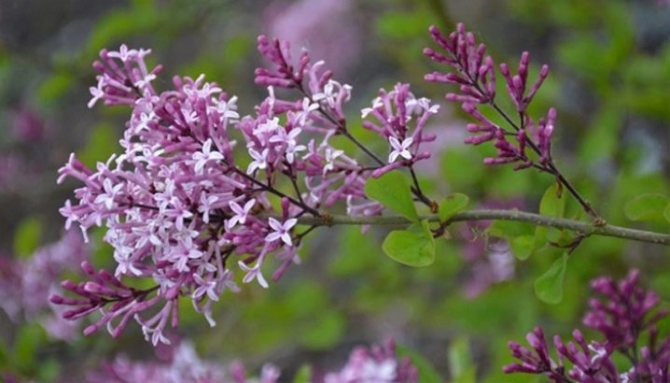
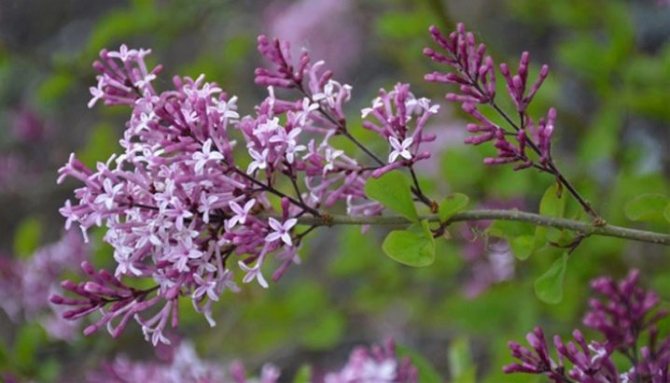
Meyer’s lilac: a description of a dwarf low-growing variety, what a lilac looks like
Any beautiful plants can be an elegant decoration for landscape design and a few square meters near a private house. In addition, such plantings look especially effective on flower beds in city parks, near public institutions, on the streets and in any other places where a large crowd of people is noticed.
Any flowers are a real find for every person, because they are able to cheer up with their unique appearance and win hearts with an incomparable aroma, which is so lacking after the exhausting winter cold and monochromatic landscape. Among the most popular flowering plants that bloom before all others, lilac should be distinguished.
Today, this excellent inhabitant of gardens and parks is represented by a huge number of varieties with different shades and sizes. There are wild specimens, and there are also elite ones grown in specialized greenhouses. Meyer’s dwarf lilac deserves special attention and respect. This undersized variety has many advantages and is in great demand among many gardeners.
General characteristics of the species
The luxurious shrub belongs to the Olive family and has about 40 natural and hybrid subspecies. The flowering period can be seen for 1,5-2 months, depending on the varietal characteristics of the individual. The first flowering elements appear in early May, remaining on the tree until the end of the first summer month. The undersized variety of Meyer’s lilac grows up to 1,5 meters, while other varieties are capable of being 10 meters in height and look like real giants. The life cycle of a plant can be up to 90 years old.
Surely everyone has ever come across the magical scent of lilacs during the flowering period. This smell is remembered for a long time and makes you once again approach the unique bush. It is very contrasting and persistent, so it quickly spreads throughout the district. Because of this feature, Meyer’s lilac bushes are often a beloved inhabitant of city parks, walking alleys, and public places. A very valuable feature of such a plant is its excellent endurance and ease of care.
Graceful inflorescences of a low-growing variety form a kind of panicles with different sizes, inside which there are miniature flowers, emitting the same unforgettable aroma. As for the color, it is represented by bright white or cream tones, or contrasting purple and fiery red. Simple inflorescences have four petals, and sometimes more. Lilac foliage is painted in dark green shades. In winter, it leaves the bush when the first night frosts appear.
Known varieties and varieties
Among the many hybrid varieties, the following are in great demand
- Dwarf Persian lilac;
- Chinese;
- Terry;
- Henry;
- Meyer’s lilac;
- Hyacinth;
- Drowned;
- Preston;
As mentioned above, Meyer’s dwarf lilac is considered one of the most popular, due to its compact size, picky nature and excellent flowering, which begins in late May or early June, depending on weather conditions. An incredibly valuable advantage of this variety is two-time flowering, therefore, at the end of summer, new flowering elements appear on the bush, however, they are not as abundant as in the first period. In any case, everyone will be able to once again enjoy the wonderful aroma of their favorite plant before the coming autumn. For productive re-flowering, faded panicles should be removed.
Also very popular, bred in the 17th century, a variety of Persian lilac, which is a spectacular combination of Afghan and small-leaved. Representatives of the variety are moderately stunted, because the maximum height of an adult rarely exceeds 2 meters. Due to the graceful thin branches, the bush looks very attractive. And 9-10-centimeter inflorescences and fragrant tiny flowers with whitish-lilac, red or purple color give the culture a more attractive appearance. In most cases, Persian dwarf lilacs bloom during the May holidays, and the flowering period continues until the last days of June. Bouquets of this variety were often used at ceremonial parades.
The terry variety is presented in a wide variety of shades and shapes, which is why it is considered one of the most popular hybrids for home cultivation. The growth of an adult individual reaches almost 4 meters, and the chic and dense foliage with an emerald color makes it truly amazing. Terry inflorescences are formed as a result of the growth of dual petals. Such plants are popular in China, as well as in the CIS countries.
Natural varieties
In addition, in nature there are many other varieties that are found in the wild. Often, in the forests there are whole thickets of fragrant bushes, which make you stop near them for a long time. Among those:
- Lilac Ordinary
- Hungarian;
- Amurskaya;
- Broadleaf;
- Small-leaved;
- Fluffy;
- Pinnate;
- Afghan;
If we consider the variety of ordinary lilac, then it served to create a wide variety of hybrids that are widespread in different regions of the world. The species is characterized by excellent winter hardiness and the ability to grow freely in dry weather. Emerald leaves form elongated hearts that taper downward. Panicle flowers cover the bush almost along with the foliage. Their color can be very different, and the aroma is amazingly fragrant.
The wide branching of the roots allows the plant to be used to protect unstable slopes from water erosion. Good growth is seen both in the shade and in conditions of abundant light. In the latter case, flowering will be especially abundant. The species calmly tolerates aggressive temperature changes.
Hungarian lilacs are found in mixed forests, where they grow up to 4-5 meters in height. It has elongated wide leaves with a darkish green color above, and gray shades below, which are on small petioles up to 1,5 centimeters in size. Flowering begins in June and lasts until the end of the month, approximately three weeks. Paniculate inflorescences in the size of 20 centimeters are painted in a pale lilac or deep purple color. They emit a very intense and specific odor that is difficult to confuse with others.
Amur lilacs are tall, because its height is 10 meters. Such a giant is easier to call a tree than a bunch. It blooms in a creamy beige that gives it a net-like appearance. At the same time, the duration of flowering rarely exceeds two weeks in the middle of summer.
The flowering shrub is in great demand in Western countries. Of particular value for flower growers and landscape designers is the undersized Meyer lilac variety with dwarf dimensions and irresistible external properties.
Features of care and growing at home
Every caring gardener repeatedly asks the question of proper care for the planted lilac in order to improve its decorative properties. To achieve this goal, it is necessary to choose well-lit planting places where there is no stagnation of groundwater at the root system, which does not react well to waterlogging and can rot. When choosing a location, preference should be given to secluded places with good protection from piercing drafts and wind.
When choosing a soil composition, preference should be given to neutral acidic soil with a comfortable but moderate humidity. It should also be fertilized with humus. At different stages of the life cycle during the growth period from spring to autumn, the land must be treated with mineral dressings, which can be urea, nitroammophoska, superphosphate and others. Organic fertilizers also perform well, including diluted chicken or cow dung.
Asking the question: “How to plant lilacs correctly?”, You need to dig a cube-shaped planting hole with dimensions of 50 x 50 x 50 centimeters. Regular fertilization, such as compost, wood ash, mullein or manure, will widen the cavity. Very often, such fertilizers are combined with each other, which significantly improves the growth productivity of the undersized variety. The bottom of the pit should be laid out with drainage from medium pebbles, expanded clay or medium-sized crushed stone. Such an event will allow high-quality drainage of excess water. The roots are carefully leveled over the surface and covered with a layer of earth. In this case, the root system should be at a level of 3 centimeters above the ground.
Features of reproduction of lilacs
There are three main varieties of lilac breeding, which are suitable for all varieties and types of plants:
- Seminal;
- Bygrowth;
- By cuttings;
Many gardeners give preference to propagation with the help of shoots, when, in the process of active growth, multiple layers appear on different sides of the plant. If they take root normally, the lilac can be transferred to a permanent place for further growth.
An equally popular way to propagate a bush is cuttings. To carry out such a procedure, you need to choose young pagons with two or three buds. The lower cut is made oblique, and all the leaves are removed above it. In this case, the upper one remains straight. The stalk is pretreated with a good stimulant of the root system, where it is placed for 10-15 hours. Then the sections are washed with clean water and planted in prepared containers. A sandy-peat substrate mixed with perlite should be used as a soil. It is important that the cuttings do not touch each other. For this, the box is transferred to a darkened place and covered with a film. Periodically, the film is removed for watering and airing.
Lilac cuttings will take out the first roots in about 2 months. If this happens at the end of autumn, the planting individual must be moved to a warm room without removing it from the boxes.
The seed propagation method is used both in the natural environment and in nurseries. Its main disadvantage is too late flowering, because the bush will give floral elements only after 4-5 years.
Trimming activities
Like many other ornamental plants, lilacs need regular and correct pruning. Young individuals under the age of three years do not need such an event.
As for the pruning of adult bushes, it is carried out in early spring, when the snow has completely melted and the temperature becomes comfortable. When pruning, 7-8 healthy buds are left, and the rest are carefully removed. Such a solution will allow the plant to direct all its energies to the development of peduncles and lush leaves. You should also get rid of diseased or dead branches using a sharp tool that minimizes possible damage.
During the flowering period, do not be afraid to cut out fragrant inflorescences up to half. Such an action will be useful for the future active growth of new peduncles. Even if you cut off more than half of the flowering elements, it will not harm the culture. However, it is better to leave some fragrant inflorescences so that the pleasant aroma is published for a long time.
Application for landscaping
The correct use of lilac bushes in the composition creates a very beautiful piece of greenhouse art. Delicate shades represented by lilac, purple or pink flowers evoke a nostalgic memory of a bright period of life. And the presence of contrasting purple inflorescences makes the plant memorable. In a special way, the culture looks elegant in single corner plantings or in the form of hedges that are planted nearby.
fikus.guru
How to choose?
In light of the high popularity of undersized decorative lilacs in landscape design, the list of varieties and varieties of this plant is annually replenished. With a large assortment, it can be quite difficult for gardeners to decide on the choice of a new plant for their site.
The advice of experienced gardeners boils down to the fact that it is worth purchasing decorative low-growing lilacs exclusively in specialized nurseries or in botanical gardens. To be sure to select healthy planting material, you should visually inspect the aboveground and underground part of the seedling. The root system will be able to indicate possible problems and diseases of the culture.
In a good young tree, the roots should not have rot or defects, in addition, you should make sure that the entire root tuber of the plant is intact.
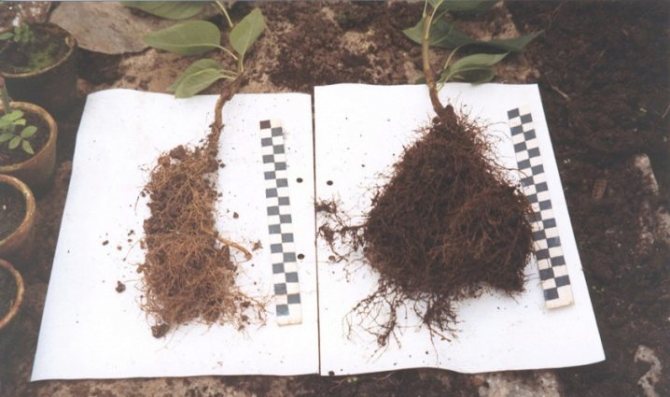
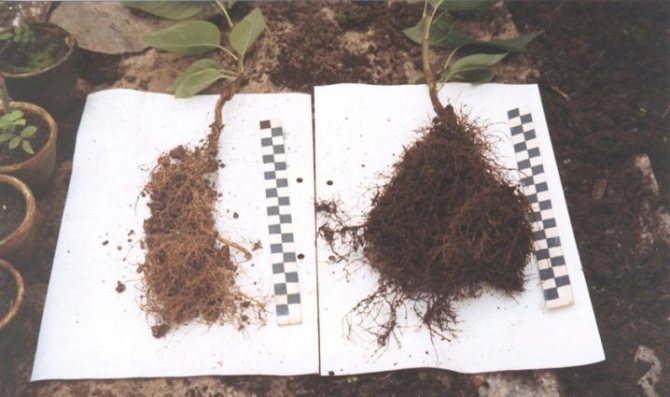
A healthy root system must be strong and flexible with many branches. The permissible root length, which is most suitable for planting, is considered to be about 30 centimeters.
And also the variety you like should have glossy buds with tight-fitting scales, the foliage of a healthy seedling will be smooth and green, with a slight gloss on the surface.
As for the selection of the variety, in this case, the choice will be based on personal taste preferences regarding the frequency of flowering and color. Almost all hybrid varieties and types of dwarf lilacs are distinguished by good frost resistance, so crops can develop even in regions with a harsh climate, provided they are sheltered for the winter.

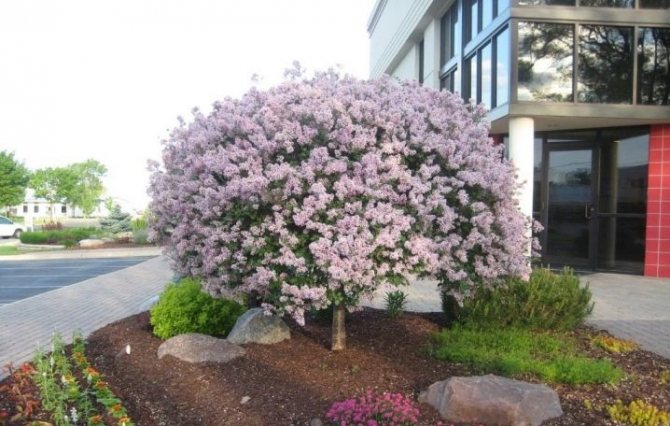
Reproduction of lilacs
- The most popular method is reproduction by shoots, when the roots are actively growing in different directions and multiple layers appear. When they are sufficiently rooted, they are transferred to a permanent growth site.
How to propagate - Cutting, no less popular method. Young pagons with two or three buds are chosen after flowering. The lower cut of the cutting is made oblique and all the leaves are removed above it, and the upper one is made strictly straight. Place the cuttings in a root stimulator for 10-15 hours. After that, the sections are rinsed with clean water and planted in boxes for grafting. Prepare a sandy-peat soil with the addition of perlite. The cuttings should not touch each other. The box is placed in a darkened place and covered with foil, making a mini greenhouse. From time to time, the shelter is removed to water and ventilate. Lilac cuttings are overgrown with roots after 50-60 days. If this happens in late autumn, then the planting specimen is left to winter in a box in a shelter.
- Reproduction by seeds can take place both in natural conditions and in specialized nurseries. Such lilacs will bloom only in five years.
Rules of landing
The rooting time of lilacs will vary based on varietal affiliation, since a feature of some crops is the need for planting in spring, other plants take root best after autumn planting in open ground. And also the choice of planting dates will relate to breeding options.
The following crops will be the best neighbors for a low-growing ornamental bush:
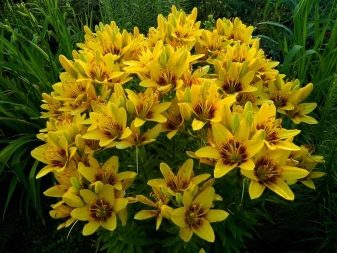
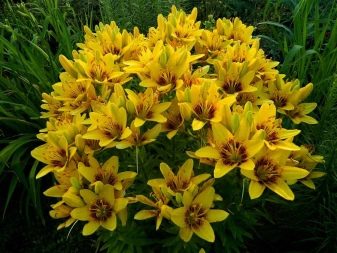
The preferred type of breeding dwarf lilac is cuttings or layering. Varietal hybrids are best planted with seedlings or vaccinated. As a rule, rooting dates fall from August to September.
For rooting in the garden, the owner of a young decorative lilac must prepare a hole, the dimensions of which will be 50x50x50 centimeters. Before disembarking, the pit should be treated with disinfecting compounds. For these purposes, you can use a manganese solution or specialized store products.
Rules for planting sirens
It is best to plant a seedling of a plant in an open area in July-August. If you do this in spring or late autumn, the shrub will either hurt for a long time or even die. A planting pit for lilacs should be 100 * 100 * 100 cm in size and have sheer walls. Before placing the bush in the pit, you should pour a substrate prepared from 15 kg of humus, 200 grams of wood ash and 20 kg of superphosphate. If the soil on the site is acidic, the amount of ash should be doubled.
It is better to plant lilacs in the evening or on a gloomy day. To do this, you need to take a plant, set it in the middle of the hole, distribute the roots evenly, making sure that the root neck remains outside. At the last moment, you should fill up and compact the substrate. The land around the bush should be immediately watered with warm water. It can also be mulched with straw or dried grass.

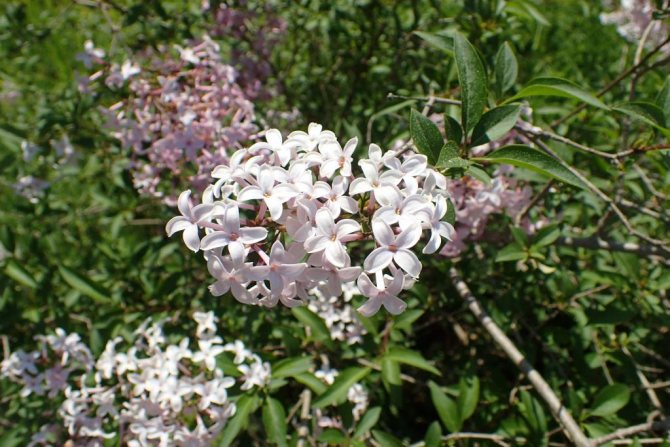
How to care?
The most important for the proper development of lilacs are the first 2-3 years after planting in open ground. During this period, the gardener is obliged to regularly perform all activities related to the care of dwarf lilacs. Among the care work, it is worth highlighting the mandatory tasks for every gardener.
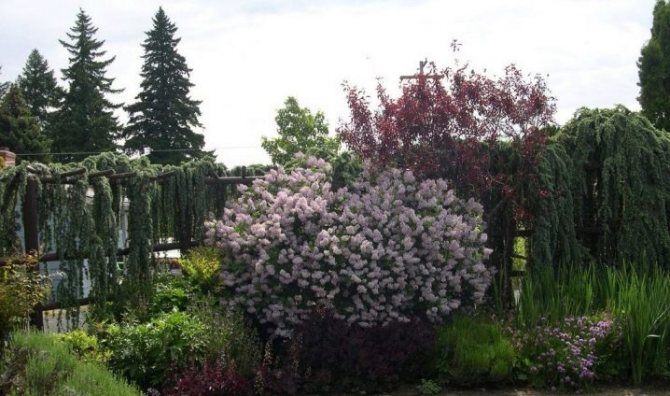
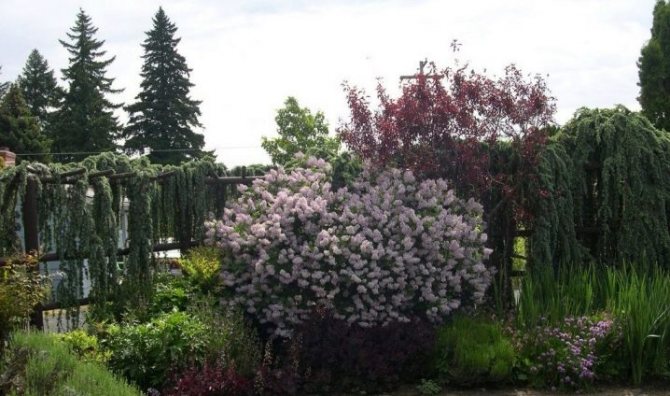
Additional fertilizing
Fertilization should be done once every 2 years. To do this, a nutritious pillow should be formed in the lilac circle near the trunk, consisting of horse manure and humus. And every spring, before flowering, organic matter must be added to the hole with a bush, but only after the snow has completely melted. And you can also use complex formulations to maintain the growth and health of an ornamental plant.


Watering
Humidification for lilacs is mandatory in the warm season, as a rule, 15-20 liters for one tree per week will be enough for full watering. With the arrival of autumn, watering should be gradually reduced, it should be reduced to once a month.


Fighting diseases and pests
A mandatory preventive measure regarding the care of dwarf lilac bushes is the treatment of the trunk circle in order to remove weeds. As well as a visual inspection for the presence of ailments or pests, all crops growing nearby are subject to. If pests or signs of disease are found on neighboring crops, they should be promptly processed with Bordeaux liquid. And also, special attention should be paid to the state of lilacs, soil and neighboring crops with heavy rainfall, in order to exclude the formation of rot on the root system. For the purpose of prevention in such a situation, soil drainage should be performed.


Lilacs rarely suffer from attacks of pests and diseases. However, the culture can be infected with some ailments.
- Bacterial necrosis – the disease usually manifests itself after flowering in the form of a change in the color of the green mass. In case of illness, the foliage becomes ashy, and the shoots turn brown. To eliminate the risk of injury, it is worth regularly thinning the bushes, ensuring good ventilation of the crown.
- Mučnistaâ rosa most often attacks young seedlings. A sign of a fungal infection is a gray-white coating on the green mass. For the treatment of lilacs, the affected parts of the culture should be removed and bleach is introduced into the soil, after which the earth must be dug up.
- Verticillary wilting – the disease provokes a fungus, in the light of the appearance of which the foliage curls and dries in the culture. Treatment is carried out using soda ash and a solution with laundry soap.
Among the dangerous pests, it is worth highlighting the leaf and kidney mites.
The first species feeds on lilac juices; with an active increase in the pest population, the culture dies rather quickly. The fight against the pest is carried out by treating the plant with copper and iron sulfate. The second type of pest hibernates on the crop, and with the arrival of spring it feeds on juices from the buds. You can destroy the insect with the help of specialized store compounds and by spraying lilacs with copper sulfate. A preventive measure that allows you to protect the culture from pests is the timely cleaning of fallen leaves, digging up the soil.


Trimming
Lilac crown formation should occur regularly. Adult crops are pruned every spring. In the course of work, about 8 buds are left on them, the rest are cut off. And also pruning involves removing dead wood. In the flowering phase of lilacs, you can cut off part of the fragrant inflorescences, which activates the appearance of new peduncles.
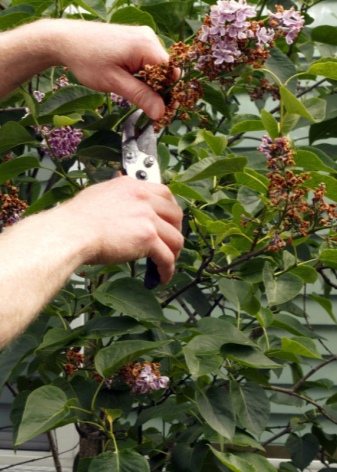
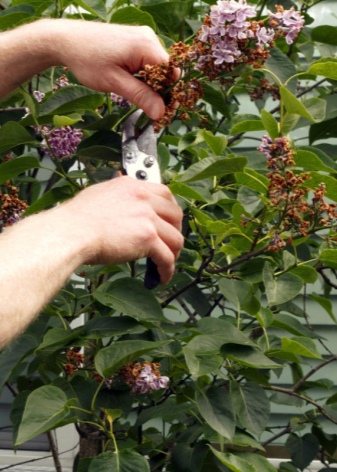
Next, watch the video review of Meyer’s lilac.
Dwarf lilac, due to its size and decorative qualities, is loved by many gardeners. Almost no summer cottage is complete without this plant. Even a beginner can handle leaving, and the variety of colors allows you to create interesting compositions.
General description of dwarf lilac
Low varieties of lilacs are perennial deciduous shrubs of the olive family. Their popularity is due to their ability to feel great in various climates.
The maximum height of dwarf lilac is 2 m, young branches are green in color with brown blotches. After a year, the shoots are lignified. The leaves can be of various shapes – oval, egg, heart, or be cut. This is determined by the variety. The fruit of a dwarf lilac is a box consisting of two oval valves, when it dries it becomes brown. The root system is branched, powerful. A young plant of low-growing varieties is gaining root strength within 4-7 years.
Dwarf lilacs are shown in the photo:
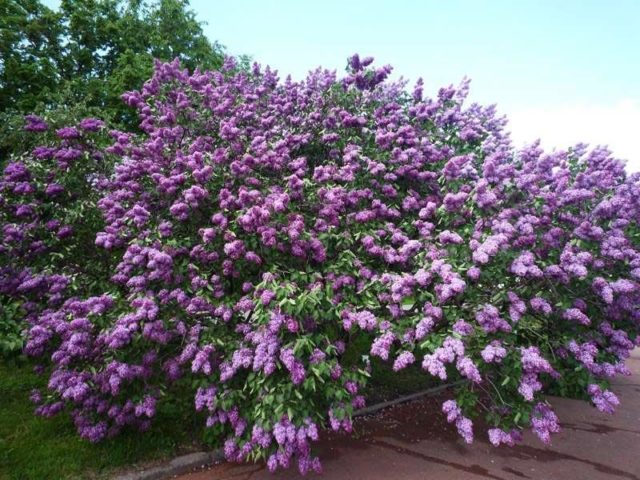
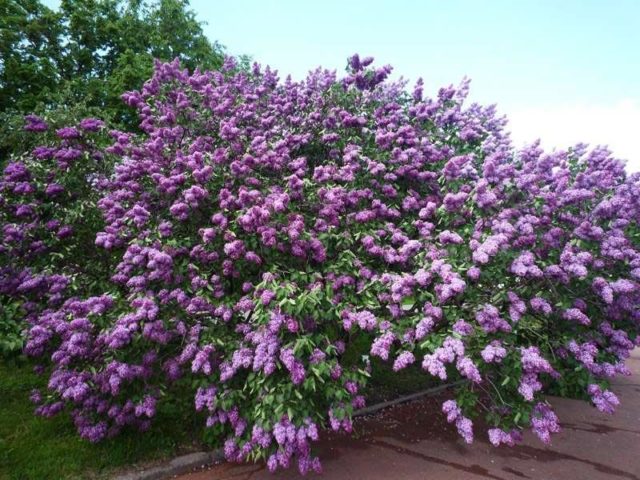
How dwarf lilac blooms
Lilacs are popular with gardeners mainly due to their small and fragrant flowers, collected in spectacular brushes. Their color can be different – white, burgundy, pink, purple, blue. The flowers are small, have up to 5 petals, but the double forms have more of them. Several medium-sized inflorescences are collected on a cone-shaped long panicle. The dwarf lilac bloom time is the end of April or May. The exact timing depends on the variety, climate of the place of growth.
Description
Dwarf lilac is a perennial plant, unpretentious, frost-resistant low tree or bush, wild and hybrid varieties will be distinguished. It belongs to the olive family.
- The branches, the trunk grow up to 1,5-2 m, the young ones are green with a brownish tinge, in the second year the branches become lignified;
- The leaves have a different shape (oval, ovoid, heart-shaped, dissected) and size, color (light green, dark green, green with white veins), depending on the variety of dwarf lilac;
- The flowers are small (simple 4-5 petals, double), collected in small inflorescences on one long panicle – cone-shaped. Flowers are white, pink, lilac, blue, purple, burgundy;
- The fruit (seeds) is a box of two oval-shaped halves with a sharp edge of green color, drying up, acquires a brown color;
- The root is powerful, branched. The seedling gains root strength within 3-7 years.
Dwarf lilac blooms in spring, late April – May, depending on the place of planting, region of growth and variety.
Advantages of growing
Summer residents love dwarf varieties for their undeniable advantages:
- good frost resistance – the shrub is able to withstand a drop in temperature to -35 ° C and does not need shelter at the same time;
- ease of care – it is enough to fertilize young plants once every 3 years;
- drought resistance – withstands up to 7 days without an additional source of moisture;
- slow growth of the shrub – there is no need to thin out a too dense crown;
- foliage absorbs harmful substances from the surrounding air well.
With all the advantages, undersized varieties of lilacs have their own disadvantages – after transplanting, the rooting process is difficult and long. The shrub requires constant care for 2 years. This disadvantage overlaps with the obvious advantages of lilacs, so its popularity among gardeners does not wane.
Correct pruning
Young, fully formed bushes up to three years old, do not need any pruning. This must be remembered.
How to prune lilacs? On the main healthy shoots, as soon as the snow melts and warm weather sets in, primary pruning is performed, while leaving 7-8 healthy buds, cut off the rest without flinching. So the bush will not waste its vitality in vain. You also need to remove any old, damaged, dead or diseased branches. Everything is done with a sharp instrument to minimize damage.
During the flowering time of lilacs, do not be afraid to cut out the fragrant inflorescences in half, this will only benefit them. You can cut off fragrant inflorescences and put in a vase or make a gift to friends or loved ones, you can do more than half, it will not hurt in any way.
But I still recommend leaving some fragrant panicles on the bush so that it continues to delight with a blooming view.
The best varieties of undersized lilacs
The dwarf lilac has many varieties, they differ in appearance, which allows you to create interesting compositions. Each grower can choose a plant that suits their specific needs. Below are the varieties of dwarf lilacs with photos and descriptions.
Meyer’s variety
The most famous undersized variety. The height of the bush is about 1,5 m, the shoots are brown-gray. The leaves are 5 cm long, in the shape of an ellipse, and at the edges they have small “cilia”. Straight inflorescences reach 10 cm. The variety is unpretentious in care, which explains its popularity. There are several varieties of this lilac:
The most popular varieties
The most popular among gardeners are the varieties of dwarf lilacs:
- “Meyera” – (“Red Pixie”, “Polybin”, “Jose”, “Bloomerang Ash”) reaches a height of 150 cm. This variety produces an interesting landscape mono-composition, blooming from spring to autumn;
- “Schoolgirl” – flowers are large, lilac-blue. It reaches a height of 150 cm, the crown has a spherical shape;
- “Monge” – the average height is 200 cm, but in some gardens it reaches 250 cm. The flowers are large, purple;
- “Madame Charles Suchet” – this variety is attractive to all kinds of pests and is not resistant to disease. The bushes are covered with large panicles of pink-lilac color, blooms profusely;
- “Captain Balte” – lilac or pink panicles, reaching a height of 150 cm.
The peculiarity of dwarf varieties is their flowering, which begins 3-7 years after planting and good care. Every year it increases its flowering exponentially.
How dwarf lilacs reproduce
To preserve varietal characteristics, dwarf lilacs are propagated vegetatively:
This method is suitable for propagation of non-varietal plants. Each type of this shrub is decorative to one degree or another, so this method can also be used.
Lilac seedlings are divided into two large groups:
- Own-rooted, obtained from cuttings, cuttings or seeds. They have a longer lifespan of up to 50 years, provide high-quality breeding material and do not form a large amount of root growth.
- Grafted – arises as a result of grafting a variety on a wild stock.
To propagate dwarf lilacs by layering, use the growth of the root mother plant itself. The grafted specimens are not suitable for reproduction.
Rules of landing and care
It is best to buy a seedling in large nurseries, so that there is no doubt about its varietal affiliation. Dwarf lilacs are planted in early spring before flowering or in autumn. The preferred period is from August to the end of September. In general, the plant is unpretentious to soils, but it feels more comfortable on sandy ones. You also need to provide good drainage. The place should be sunny and protected from drafts.
The landing algorithm is as follows:
- The place is disinfected with a fungicide or potassium permanganate 3 days before the seedling is placed.
- The size of the hole should be 2 times larger than the root of a young plant.
- A drainage layer and sand are placed at the bottom.
- Prepare a soil mixture with biofertilizers or a complex agent with nitrogen.
- The pit is filled with warm water.
- The seedling is buried in the evening, tamped down and watered well.
If all the conditions are met, the bush will root well, but it will take a long enough time for it.
Location and soil requirements
After you bring the Persian lilac seedling home, it will need to be placed somewhere right away. The landing site should be chosen so that it is well ventilated, but at the same time, it is closed from drafts. Experienced gardeners recommend placing printed Persian lilacs (well, or other varieties) near the walls of sheds or other household buildings. The soil on which the plant will be located must be fertile, moderately moist and well-drained.
Low and waterlogged soils that are flooded in spring / autumn are not suitable for growing shrubs. As well as heavy clay. If the land on the site is acidic, you can lower the pH level by adding lime. And one more thing: the Persian lilac, though low, is quite spreading. If several bushes will be planted on the site, a distance of 1,5 meters must be left between them.
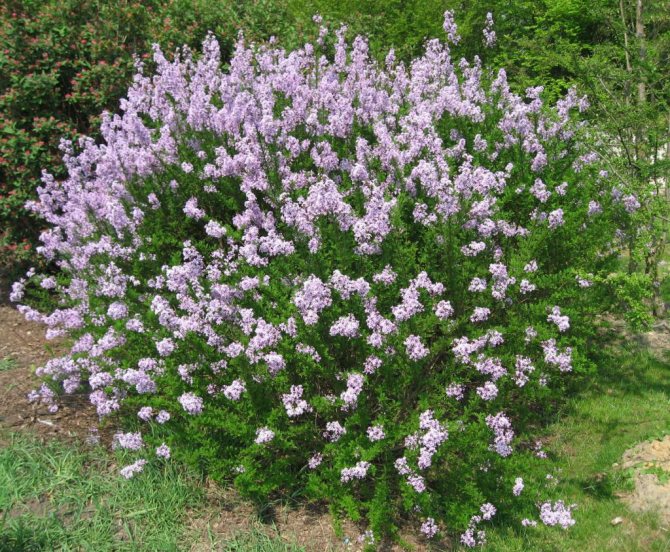
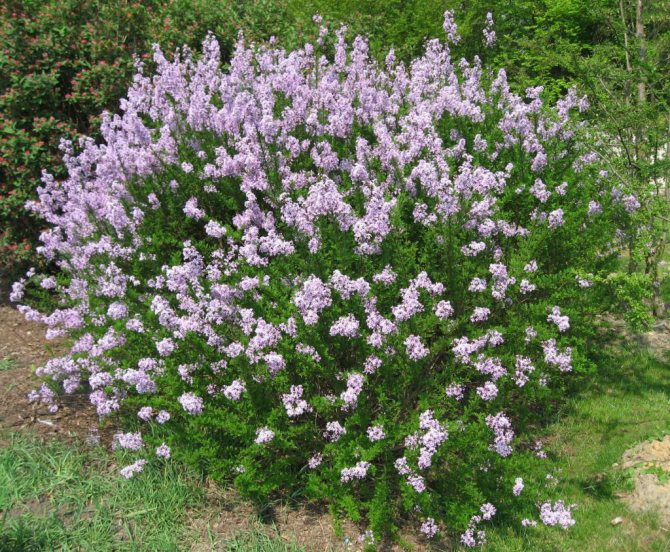
Growing rules
When growing dwarf varieties, you must adhere to the following rules:
- To carry out timely pruning, most often it is sanitary or anti-aging. As a rule, it is not required to form a bush. The main thing is to remove faded brushes from the bush in time.
- With a frequency of once every 2-3 years, a cushion of nutrients is formed in lilacs – manure or humus is introduced. As soon as the snow melts, then organic fertilizers are applied. The height of such a pillow should not exceed 7 cm.
- Dwarf bushes are watered no more than 2 times a week, 15-20 liters each. At the end of summer, they are reduced to 2 times a month.
- Despite the fact that the frost resistance of the plant is quite high, for the first winter the bush is insulated with straw, spruce paws or sawdust.
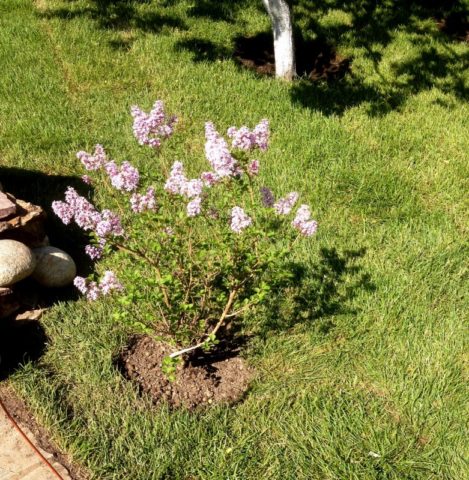
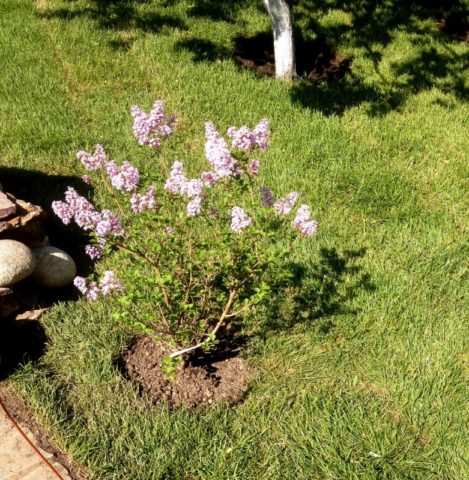
Even a novice gardener can follow these recommendations.
Beauty Moscow
The variety has graceful, very fragrant double flowers, pale pink with a silvery hue. Inflorescences are formed from several pairs of loose and lush panicles.
“Beauty of Moscow” blooms profusely if it grows in well-lit areas. Growing in damp lowlands and in deep shade is destructive. Flowers have a diameter of 2,5 cm, regular shape, symmetrical. In the stage of incomplete blooming, they look like charming little roses.
The buds are large, spherical with a glossy shine. The inflorescences are located strictly vertically. Lilac bushes of this variety are spreading, grow no more than 2 m in height. It blooms from May to June: annually and very abundantly. This variety is recognized as the most beautiful of those that have been bred.
Pests and diseases
Lilac diseases are divided into several groups:
- Viral – mainly annular speck, annular spot, chlorotic spot. Practically they are not treated, the plant must be destroyed, and the place is disinfected. Protection of lilacs consists in the observance of preventive measures, which include protection against insect vectors and treatment with special agents.
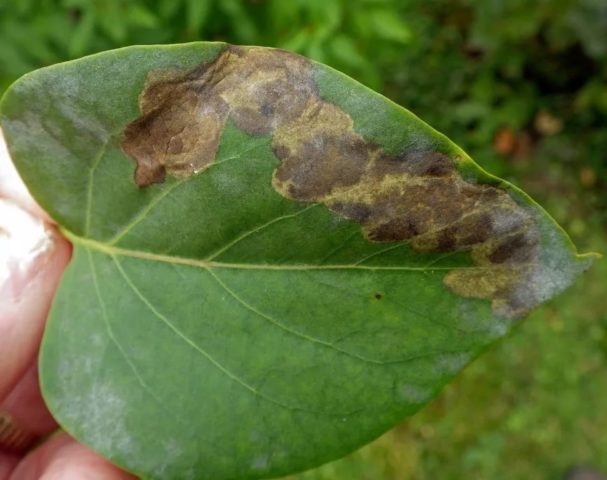
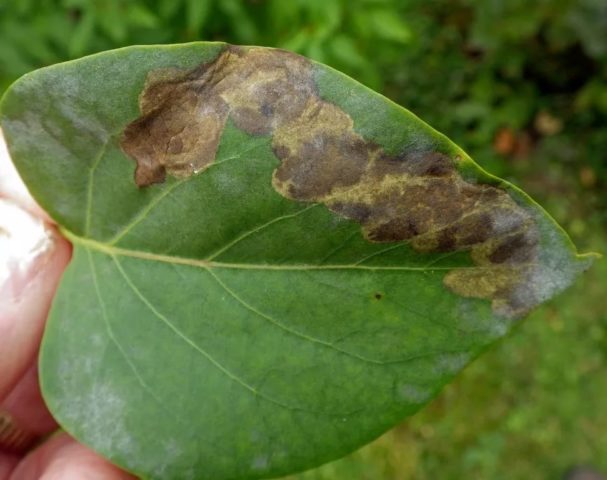
- Fungal – ascochitis, anthracosis, alternaria, septoria, cercosporiasis, brown spot. On the diseased plant, spots of various sizes and colors appear, depending on the type of pathogen. Fungi develop at high temperatures above + 25 ° C and humidity. For prevention, lilacs are sprayed with preparations containing copper. In order to avoid illness, dry leaves and shoots must be removed in a timely manner.
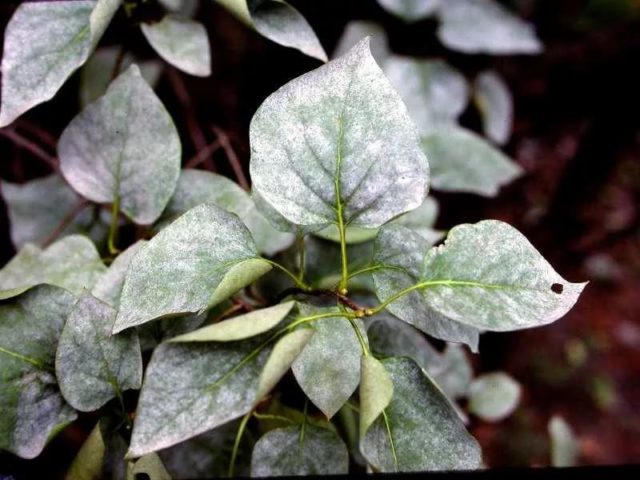

- Bacterial – these include wilting, bacterial rot. Occur in thickened plantings. There are varieties with resistance to this group of diseases.
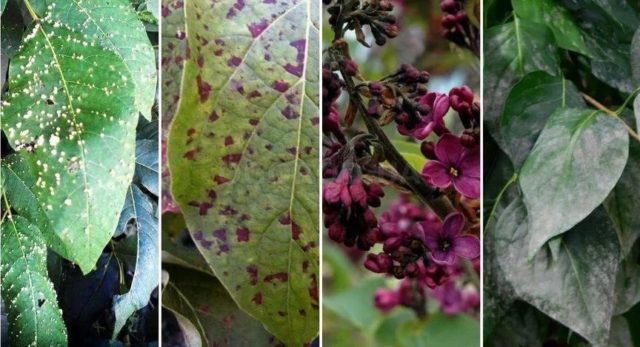

- Mycoplasma – the most common problem is paniculate. Lateral shoots grow, but internodes do not develop. This leads to the fact that the branches become like small bushes, the plant looks like a dwarf and gradually dies. Mycoplasmas lead to jaundice, rosette, chlorosis, small leaves. Preventive measures include the destruction of insects that can carry disease and disinfection tools.
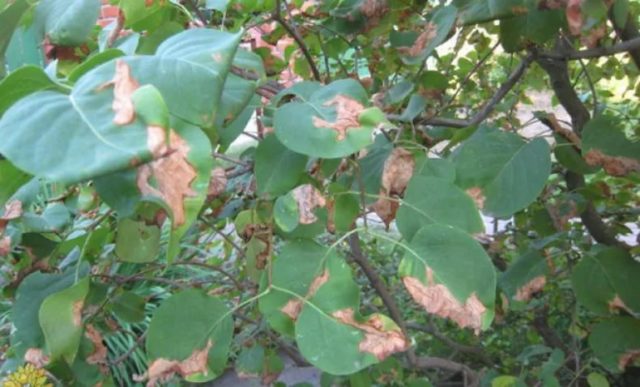
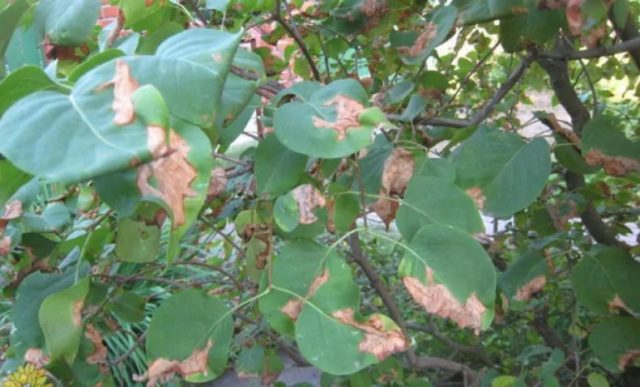
Pests are also found on dwarf lilacs. The main ones are: - Acacia false shield – lives on thin shoots and leaves. The accumulation of eggs resembles heaps of white powder. The twigs dry out, the flowers lose their decorative appearance, the resistance to cold decreases. A preventive measure is the removal of dry branches, overgrowth, thinning the crown.
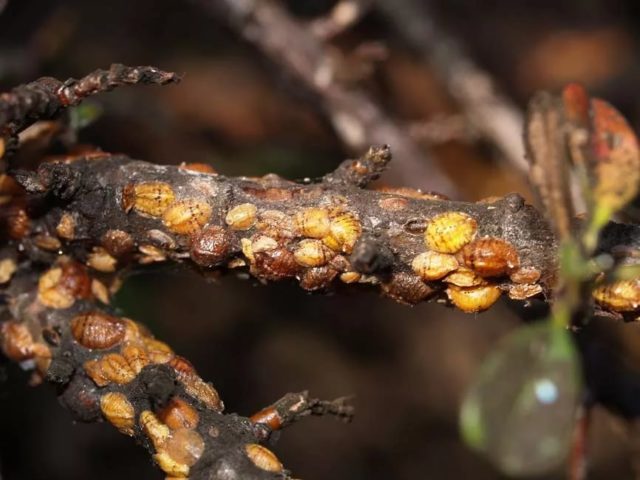
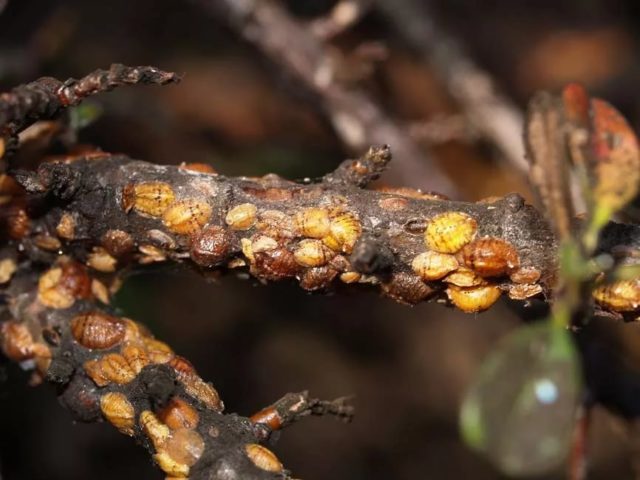
- The apple comma-shaped scale insect is a dangerous pest that lives on the trunk and shoots. Females and their larvae are affected by lilacs. The insect sucks out the juice, and the plant weakens.
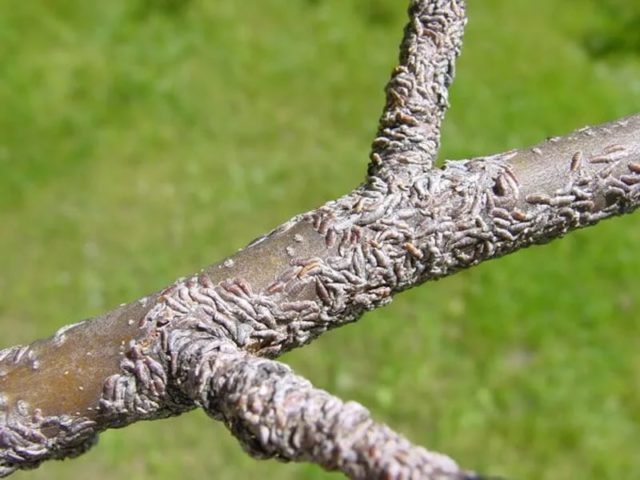

- Lilac speckled moth is a brown butterfly about 1,5 cm in size. Their caterpillars live under the leaves, twisting and destroying them. Digging up the soil under the bush by 30 cm will help get rid of the pest.

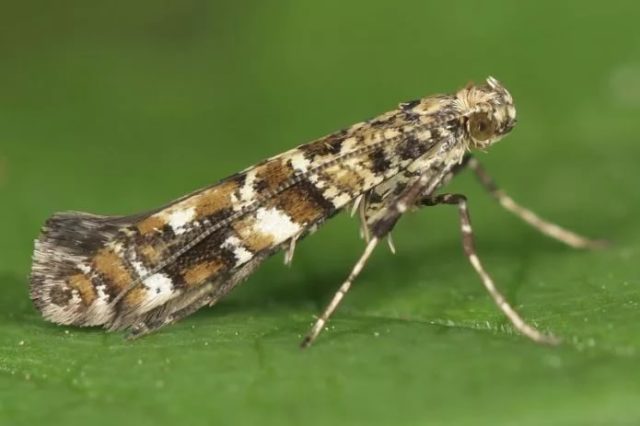
- Rose leafhopper – often found on lilacs, larvae and adult insects drink juice from leaves and shoots. Special drugs will help against it.
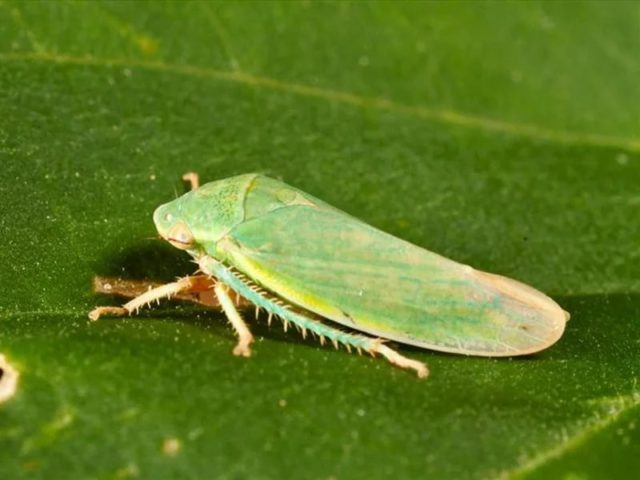
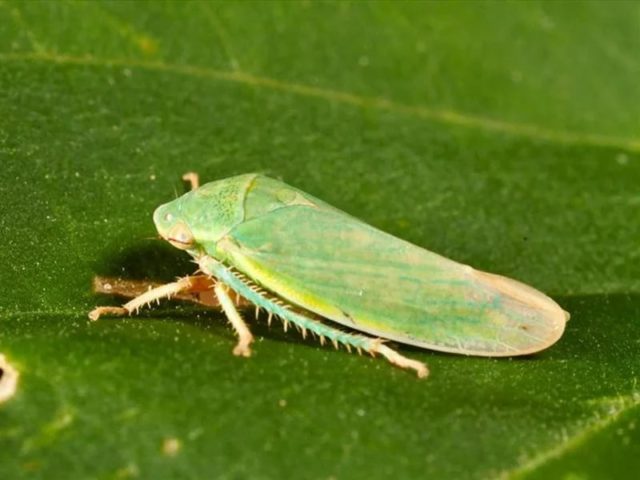
- Weevil is a beetle that gnaws leaves. It is not active during the day and is located under the bark, and at night, in the morning or in the evening, it begins to actively eat. Destroyed with special insect repellents.
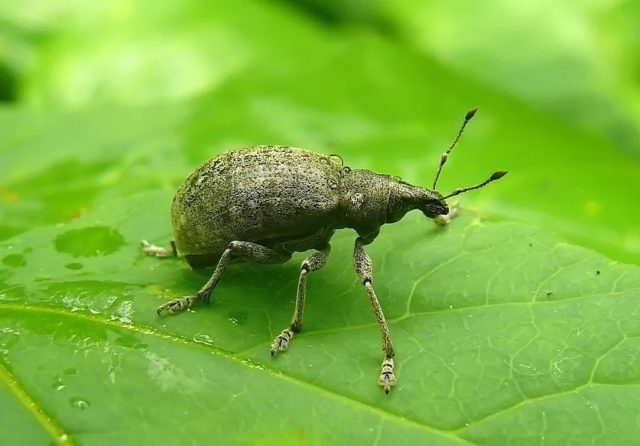

The use of undersized lilacs in landscape design
Dwarf lilacs are widespread in landscape design – they are good both in group and in solitary plantings. Sometimes several seedlings are placed in one hole, so that they then grow together and form a powerful bush.
The Meyer variety is used for hedges due to its compactness. The plant is undemanding to soil fertility, takes root well and tolerates dense plantings. The dwarf variety goes well with low-growing conifers.
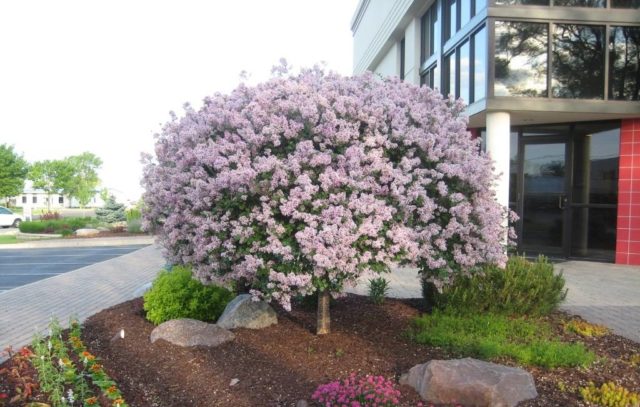

Peonies are often planted with lilacs, the flowering period of which coincides with it. This composition is very colorful and aromatic. A recent fashion trend is to place dwarf lilacs on alpine slides. Also, connoisseurs often plant a bush with white flowers in a large flowerpot. Thus, you can save lilacs from a number of diseases.
Persian lilac varieties
There are only 3 of them, since the plant is difficult to select and it is very difficult to grow it from seeds. It:
- Alba is a dwarf Persian lilac with snow-white flower clusters, from which a not harsh, sweetish aroma emanates.
- Laciniata – It can be recognized by its small whitish-lilac inflorescences hanging from thin twigs and bending downward.
- Nibra is a shrub with lush purple-pink clusters.
You can see a photo of Persian lilac just below. But remember: in Russia this plant is extremely rare due to the fact that it does not tolerate frost well. It can die already at minus 10 – this is evidenced by reviews of gardeners, who still dare to grow shrubs on their personal plot.
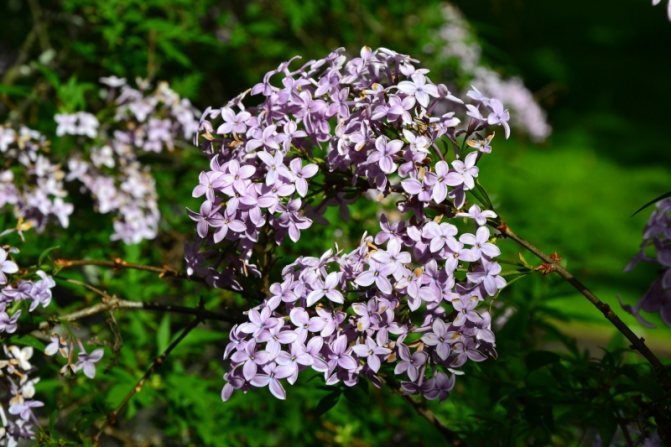
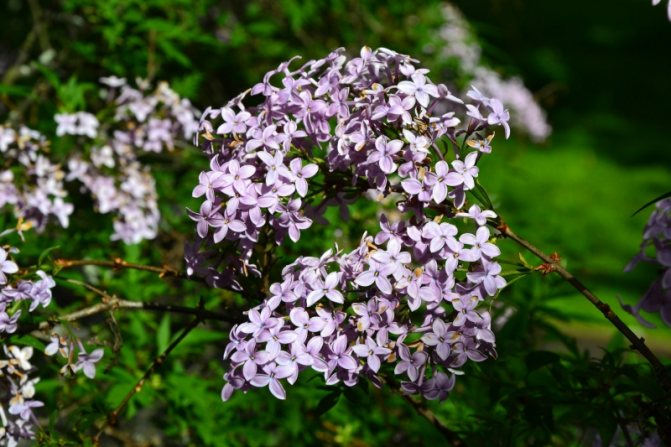
Reviews
Not so long ago, landscape designers proclaimed the fashion for compact lazy gardens. For landscaping the mini-garden, dwarf lilacs are often used, its varieties are diverse, it differs from other crops in unpretentiousness in care, low regenerative performance, and resistance to environmental influences. In accordance with the established concept, the owners of suburban areas have the opportunity to save their time and effort in caring for plant compositions and flower beds.
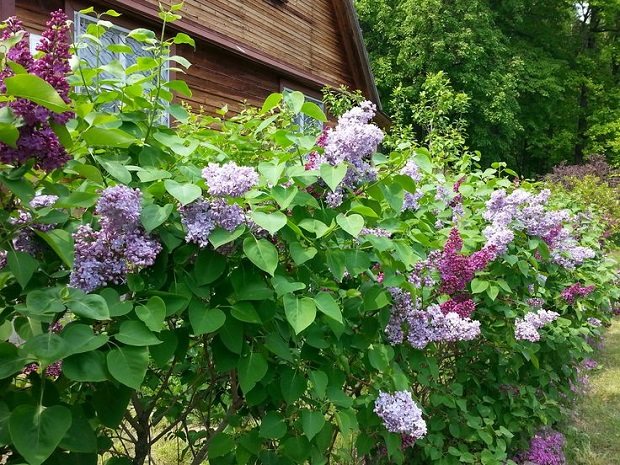

Advantages and disadvantages of undersized lilac
Among other mini-shrubs, dwarf lilac stands out for a number of advantages. These include:
- High frost resistance. Some varieties are able to withstand temperatures as low as -40 ° C without additional insulation.
- Unpretentious care. One organic feeding of a young plant is enough for 2-3 years.
- Drought resistance. The shrub can withstand up to 7 days in the heat without additional irrigation.
- Low vegetation potential. Perennial dwarfs are characterized by slow growth rates, and therefore gardeners do not have to worry about crown density.
- The crown’s ability to absorb exhaust gases and toxic volatile compounds from the surrounding atmosphere.
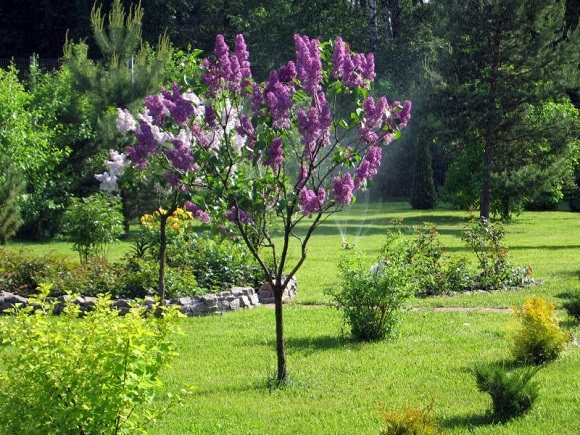
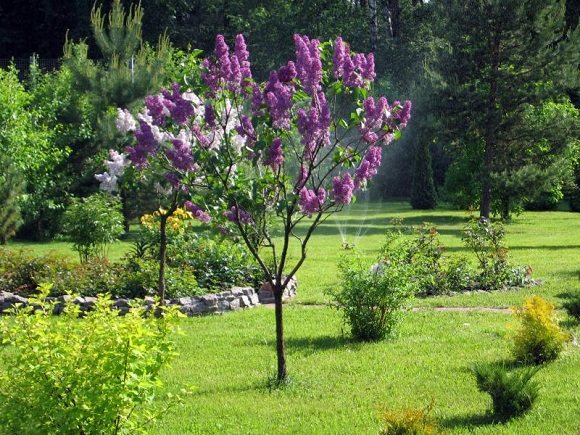
Among the shortcomings, it is worth noting the low rooting rates. Most of the undersized varieties (except for Mayer’s species) get sick for a long time after transplanting to a new place. In the first 2 years after the manipulations, the plants need more careful care.
Popular dwarf varieties
In Russian park areas and suburban areas, the following varieties are considered the most common:
Video from Igor Bilevich with an overview of the undersized variety.
Meyer’s species includes several popular low-growing varieties: Palibin, Bloomerang Ash, Jose, Red Pixie. The novelty of the last decade is the Flowerfest series with the varieties “Pink”, snow-white “White” and purple “Purpl”, not exceeding a meter height. Bud formation is possible in early and late summer.
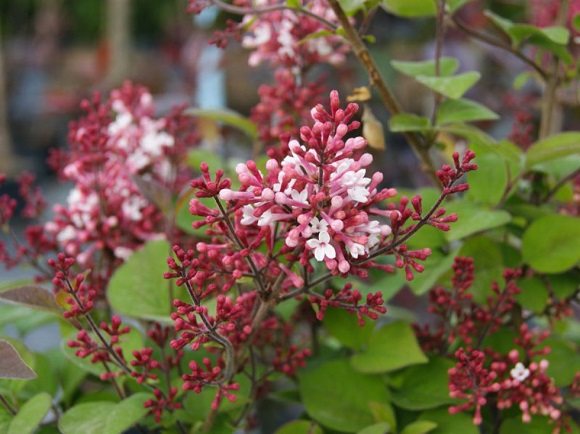
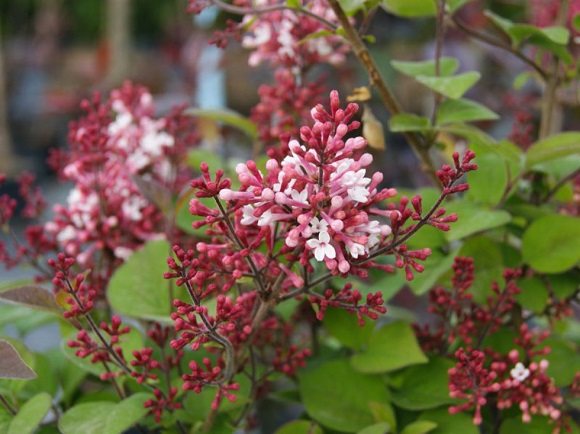
The small-leaved species is represented by the only compact variety called “Superba”. This is a presentable shrub up to 1 m in height with beautiful magenta-colored inflorescences. It is frost-resistant, successfully transfers transplantation and severe winters. Needs sufficient sunlight. In the shade and partial shade, the inflorescences become smaller and crumble faster. The flowering period is 20 days, the blooming of the buds begins in early June.
The group of dwarf lilacs, called the balcony in everyday life, is represented by several more popular varieties:
- The schoolgirl is a kind of common lilac, which is distinguished by its miniature crown size (up to 1,5 m) and large paniculate inflorescences up to 25 m in length. The flowers have an intense lilac color and a delicate yet persistent aroma. Resistant to environmental influences and sudden temperature changes.
Olympics Kolesnikov
A very original and recognizable variety thanks to its mauve double flowers. In addition, a feature of the Kolesnikov Olympics is the dark coloration of annual shoots. The lilac bush grows up to 3 m in height, the crown diameter reaches 2,5 m.The leaves are heart-shaped, dark green in color, shiny. Blooms profusely from late May to mid-June. The inflorescences are very large, spreading, fluffy and fragrant. Consist of two strong panicles.
The flowers are large, each with 3 petals. The lower petal is strongly curved upward, and the upper ones are pressed to the center of the bud. Kolesnikov Olympics bears fruit in August. The variety has frost-resistant properties. The ideal landing site is a sunny area or an area with light shade. This variety of lilac is used to form city alleys and compositions with trees and other shrubs.
Is there a dwarf lilac with repeated flowering?
Science and breeding do not stand still. Every year, breeders around the world are developing more and more new varieties of lilacs. Among them, there are both classic and re-flowering variations.
Among the undersized varieties, it is customary to distinguish plants with the following names:
- Bloomerang Purple is a hybrid of the Meyer species up to 1,5 m high. The primary formation of buds occurs in May, the second wave should be expected in August. Purple inflorescences with a lavender hue and a memorable floral scent can stick to the shoots until the first frost. To achieve a profuse second flowering, it is recommended to remove the previous faded panicles in a timely manner. Perfectly withstands short-term frosts down to -32 ° C.
Dwarf Shrub Care Workshop
In the first years after transplantation, lilacs need special care, since, due to the slow rate of rooting, it is most susceptible to garden pests and diseases. However, by observing a number of planting and care requirements, gardeners can avoid most of the problems:
- The hole, flowerpot, pot must be sprayed with a disinfecting solution before planting. It can be potassium permanganate or a special preparation purchased from a gardening store.
- The root ball is sprinkled or spilled with a growth stimulant (Kornevin, Zircon).
- After transplanting for a month, lilacs are shaded at noon with the help of awnings or homemade domes.
- Root suckers and side shoots are cut at the root to avoid overgrowth of the seedling. This measure is necessary to prevent the degeneration of hybrid bushes.
- Lilac, like any ornamental deciduous plant, needs timely pruning. The faded panicles, removed in time, save the strength and nutrients necessary for the establishment of flower buds for the next year. This rule should be taken into account when you have to prune roses after flowering. But this does not mean that you can break off branches from a bush. Bare, deformed shoots are vulnerable to a variety of diseases and pathogens.
- In addition to pruning, the plant needs nutrition. To do this, once every 1-2 years, a nutritious pillow is formed in a hole with lilacs, consisting of horse manure or humus. In mid-March, after the snow melts, organic fertilizer is poured into the garden bed with the bush. The height of the pillow should not exceed 3-6 cm.
- The first wintering of dwarf varieties should be gentle. Regardless of the indicators of frost resistance of the shrub, the hole under it is insulated with straw, sawdust or spruce branches. Before sending plants into hibernation, you must take a photo of them with a description. This measure helps to remember the timing and location of each landing.
Video with tips for care from Andrey Tumanov.
The use of dwarf lilac bushes in landscape design
Miniature varieties of lilacs are used both in group and in specimen plantings. In the second case, gardeners recommend planting 2-3 seedlings in one hole. During growth and development, seedlings grow together, forming a single strong bush. Such tapeworms are distinguished by a lush crown and an exotic look.
Meyer’s dwarf species most often form hedges. This is due to the fact that these shrubs are not prone to raising the crown, have compact dimensions of the root ball and cost a small amount of nutrients. Due to these features, the shrubs tolerate dense planting and frequent transplants well.
Lilac bushes are combined with undersized spruces and other conifers. Gardeners do not have to worry about the safety of this deciduous crop. Despite the fact that evergreen seedlings have powerful rod-type rhizomes, they will not be able to draw on themselves the full volume of moisture and nutrients from the soil.
Peonies of contrasting shades are planted under lonely bushes. This is due to the fact that the timing of flowering of these crops coincide. At the beginning of summer, the plant composition pleases the owners of a compact garden with a lush color and persistent aroma.
The current trend of recent years is the decoration of alpine slides with lilacs. Such undersized varieties as “Captain Bolte” and “Madame Charles Suchet” are often diluted with stony compositions.
The highlight of the garden is a low bush of white lilac, planted in a large flowerpot. This specimen composition not only adds sophistication to the local area, but also saves space, protects the plant from many soil diseases. For example, Madame Charles Suchet, sensitive to fungus, is recommended to be placed in open areas exclusively in garden pots.
Dwarf lilacs are suitable for growing in gardens, open terraces, greenhouses and greenhouses. Some renovation types are able to decorate the interiors of houses.
Contents:
- Growth rates
- Flowering
- soil
- Sun
- Watering
- Reproduction and care of the Persian lilac
- Additional fertilizing
- Trimming
This lilac variety is remarkable in that it is smaller than its counterparts. Due to their compact and fluffy forms, these bushes look great as a tapeworm, in flower beds, and also as hedges.
Persian lilac is a hybrid created by crossing the lilac lilac (Siringalaciniata) with the Afghan lilac (Siringa Afghanica).



